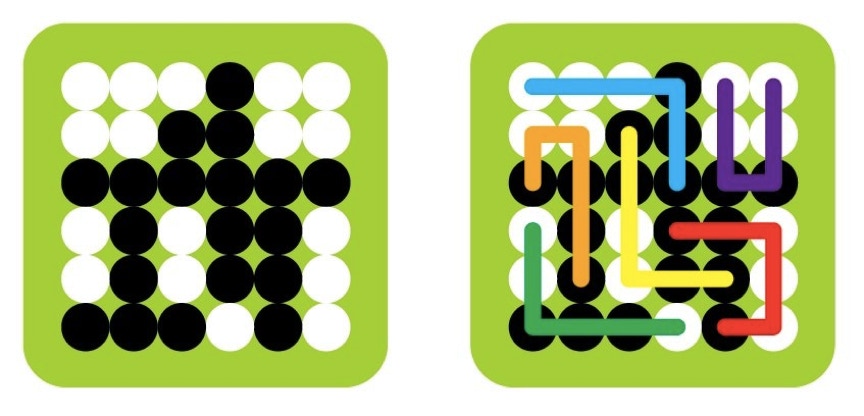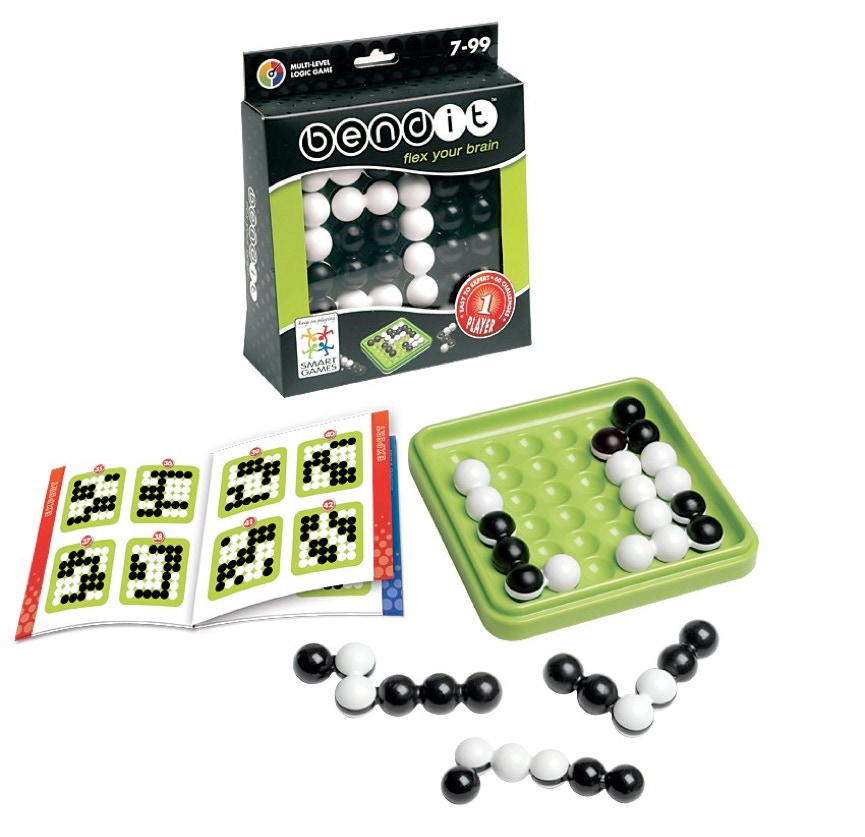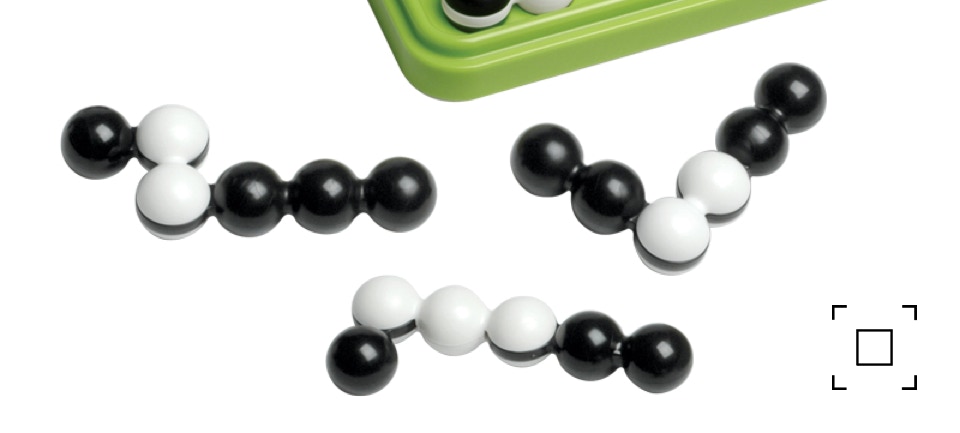Bend-It
The story behind the creation of Bend-It
Raf Peeters, January 2012
Bend-it is another SmartGame with ball shapes I invented for 2012. The tagline says “flex your brain” and I definitely flexed mine when I developed this puzzle. The balls are a lot bigger than those of IQ-Fit or IQ-Puzzler, but that’s not the only difference.
THE SOLUTION = THE CHALLENGE
You have 6 puzzle pieces and the object is to use them to fill up the grid but… this time the challenge shows you how the solution will look like! When you start you already know the color of every ball (either white or black) but you don't know which balls are part of which puzzle pieces.
To complicate things a little, every puzzle piece is made from both white and black balls AND each puzzle piece can bend in 2 places 90°, so it can transform into different shapes. 4 puzzle pieces can have 9 different shapes, the other 2 puzzle pieces can only be bended into 6 different shapes. This sounds difficult, but it isn't that hard to solve, if you know what to look for. If you want to find out yourself, just skip the next paragraph. But if you don't have any clue yourself, check out the hints below.
HOW TO SOLVE BEND-IT?
There is only one puzzle piece with one white ball (indicated with a green line in the solution) at one end. You can easily find back this puzzle piece in challenges where you can find one white ball that is not adjacent to other white balls.
There are only 2 puzzle pieces (red and orange) with one black ball at the end. If you see a black ball that is not touched by any other black balls, you know that you need to use one of those 2 puzzle pieces.
The puzzle pieces indicated with a blue line, has 3 white balls in a row. There are more ways to make this 3 white balls in a row, but with this puzzle piece there will also be a black ball on the same row next to it.
Every puzzle piece is a combination of white or black balls. Look for areas where there are a lot of balls of the same colors close to each other. These areas are always made with different puzzle pieces.
Look for patterns that are easy to remember. Two puzzle pieces (yellow and purple) are made of a combination 2 white - 2 black - 2 white or visa versa.
When you create an empty area on your game board surrounded by balls, this space should always have a number of places that is a multiple of 6. When you now look back to the challenge on top of this page, you will see that this challenge can easily be solved using the clues A and C. Every challenge has clues like these, but harder challenges have fewer than easier challenges. If you don’t look for clues, it’s just a trail and error game, but if you use your brains, it becomes what it really is: a logic puzzle.
FLEX YOUR BRAIN
Although I normally prefer to play puzzle games with a theme, I really liked this one too. The reason for this is that once you understand how the game works, you can already solve a lot of challenges, only by using logic. Other games often require you to check a lot of possibilities one by one, which is not really my cup of tea.
It's also the first game were I could solve all challenges in 5 to 10 minutes. In most other SmartGames I designed it was hard to find challenges that you could solve in that time frame. Challenges are often easier (less than 5 minutes) or much harder (more than 10 minutes). But this game was different. That is probably another reason why I enjoyed to play it. Good challenges should not be too hard or too easy. To make real easy challenges possible, I added hints to the STARTER level. The first 2 challenges show you the position of 4 of the 6 puzzle pieces. The following challenges show you fewer hints. The other levels don't show you any hints.
GESTALT PSYCHOLOGY
There is some psychology involved with this game. People are very focussed on recognizing patterns, even if they are not intentional or don't make any sense. When you look at a challenge, your mind thinks that groups of balls with the same color belong to the same puzzle piece (which is often not the case). This makes solving the challenges confusing when you start playing with it.
UPDATE 2012: There are 3 small errors in the challenge booklet with date code 20120220 of Bend-it. Challenges 30, 52 and 56 should have 19 black balls instead of 18. Coloring the 3 white balls black solves the issue. These errors are only present in the first print run of the booklet. In more recent versions this is corrected.
UPDATE 2021 There is now a very simple game that uses a similar mechanism for the puzzle pieces: Apple Twist.

example of a challenge (left) and solution (right) of Bend-It






GAME RULES BEND-IT
1) Choose a challenge
2) Put all 6 puzzle pieces on the game board. Every playing piece consists of three parts and can change shape. The challenges of the STARTER-level show you the shape and the position of one or more puzzle pieces. At all other levels you will have to figure that all out for yourself.
3) You have found the solution when the colors of the balls on the game board match with the ones on the challenge. There is only one correct solution, found in the back of the booklet.
Website ©2024 Raf Peeters
Products and images: © Smart
